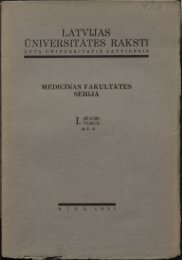UMIVERSITATIS LATVIENSIS - DSpace
UMIVERSITATIS LATVIENSIS - DSpace
UMIVERSITATIS LATVIENSIS - DSpace
Erfolgreiche ePaper selbst erstellen
Machen Sie aus Ihren PDF Publikationen ein blätterbares Flipbook mit unserer einzigartigen Google optimierten e-Paper Software.
Dixon (1926) has considered as being identical with U.<br />
lutea the following Orthotrichum species of R. Brown: O. gra-<br />
ciHimum, O. flexifolium,<br />
O. tortulosum, O. parvulum, and has<br />
suggested that 0. erectum R. Brown ter. in Trans. N. Z. Inst,<br />
vol. 27, p. 441 (1894)<br />
and O. otiraēnse R. Brown ter. in Trans.<br />
N. Z. Inst. vol. 35, p. 333 (1902), the types<br />
seen, may also belong to U. lutea. Through<br />
kindness I have been able to examine the types<br />
of which he had not<br />
Mr. H. N. Di x on's<br />
of the 4 first-<br />
named species and can prove that O. gracillimum certainly<br />
belongs to U. lutea in the delimitation given in this paper. The<br />
3 other species will be found below in their respective places.<br />
As to the two last species, the types of which are presumably<br />
lacking in R. Brown's herbarium, nothing<br />
definite can be said.<br />
As is to be seen from the list of the localities from which<br />
specimens have been examined, b. lutea is not rare in Tasma-<br />
nia and in the South Island of New Zealand. From the North<br />
Island of New Zealand I have seen no plants and from Australia<br />
the only one is the specimen mentioned above. Another speci-<br />
men from this country labelled as U. lutea I found in C. Mül-<br />
lems herbarium, but it proved<br />
to be Orthotrichum tasmanicum.<br />
It may be met with in other herbaria too. It is labelled: "Vic-<br />
toria, leg. F. M. Campbell, 1889".<br />
I To U. lutea belonged all specimens<br />
and a part of those determined as U. fulva<br />
determined as U. crispa<br />
Brid. In spite of<br />
Wa 11 s & Whitelegge's (1905) and Rod w a y's (1914)<br />
data neither species occurs in Australasia, the first being confined<br />
to the Northern Hemisphere and the second to the Madagascar<br />
region.<br />
9<br />
1<br />
Ulota brevisetcr n. sp. )<br />
Autoicous. Leaves curled when dry, erecto-patent when<br />
moist, lineal-lanceolate, subacute with a broad, oval or widely<br />
oval, concave base, caniculate; margins usually plane, some-<br />
times recurved at one side, minute denticulate in the upper part<br />
of the base; nerve protruding on the back. Cells in the middle<br />
of the base narrow and incrassate, at the margins<br />
of the base<br />
up to 10 or more rows of cells forming a conspicuous hyaline<br />
band; cells in the upper part of the leaf small, ca. 8 \i, minu-<br />
tely and densely papillose. Perichaetial bracts very broad, lan-<br />
J<br />
) Folia sicca crispata, c basi vel oblonga obovata lineari-lanceolata, cel-<br />
lulis basalibus externis in seriebus pluribus limbum hyalinum latum efformanti-<br />
bus. Vaginula nuda vel sparse paraphysata. Seta breviuscula. Theca subcy-<br />
lindrica sub ore coarcata, stomatibus ad basin thecae positis. Calyptra valde<br />
piloša. Peristomium duplex infra orem longe insertum.


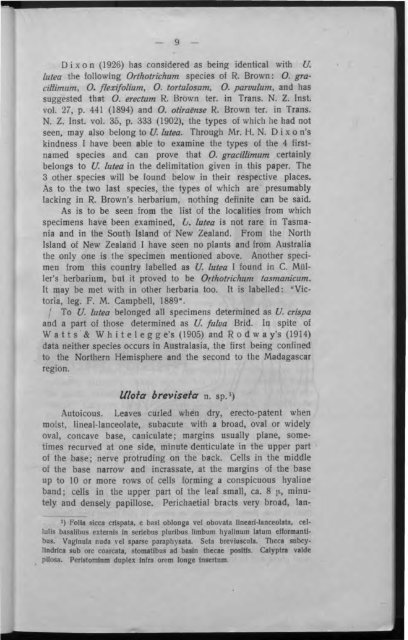
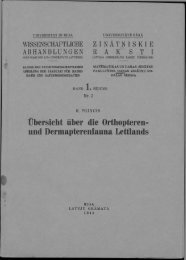
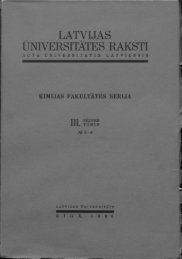
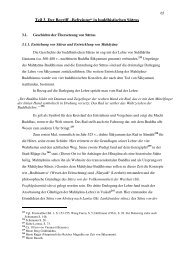
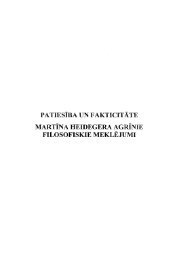
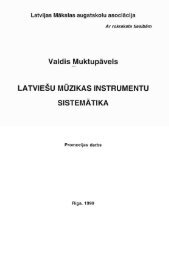
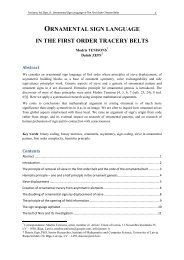
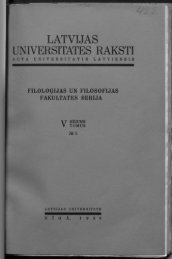
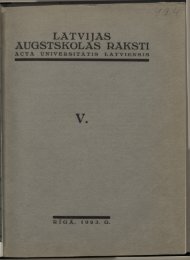


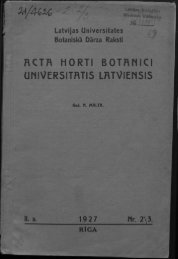
![LATVIJAS] - DSpace](https://img.yumpu.com/11778577/1/190x249/latvijas-dspace.jpg?quality=85)
